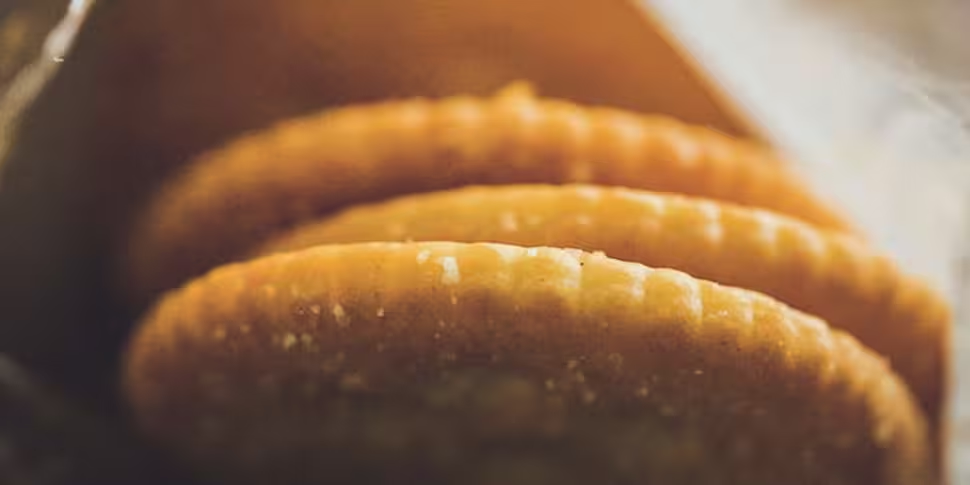Automation can be beautiful. For all the glory and skill of masterfully recreating recipes at home, sometimes it’s the bounty of uniformity that counts. Never is this more apparent than when it comes to crackers, which stand, in neat and perfectly ordered piles, in packets and boxes and tubes, each one identical to the last, give or take a couple of broken ones at the top and bottom. Their plainness is their virtue, small and salty discs and tiles waiting to deliver heaped piles of cheese, meats, dips, or even a thick grouting of butter. The cracker snaps with a moreish crisp in your mouth, the little savoury biscuits crunched up and mashed into gaps in your teeth – unless, like my father, you like to dip them in your tea first. There are as many types of cracker as there are among the biscuit family, with Dublin’s own W and R Jacob’s cream variety undoubtedly the crème de la cracker. But it’s the Ritz that deserves a special nod, given its long history of masquerading as an apple.
For the unfamiliar, the Ritz is reassuringly simple; the small discs, lightly salted on one side and with their signature scalloped edges, fit comfortably into the palm of even a child’s hand, leaving behind a slightly greasy residue that accounts for their buttery taste.
In November 1934, the National Biscuit Company, the snack brand behind the Oreo, developed the Ritz recipe while looking to produce an affordable snack while the Depression stretched on. Trialling the cracker, it proved so successful that Nabisco, as the company would later become know, mad moves to bring them to market as soon as possible. Of the name, Ritz is a nod to César Ritz, the famous Swiss hotelier whose chain of luxury hotels across Europe and the US had enough name recognition to instantly conjure notions of opulence and glamour, even when plastered over a plain biscuit.
Ritz Crackers are usually pulled straight from the box and into the mouth, though they can often be sandwiched with savoury fillings, like peanut butter or soft cheese. But beginning in the 1930s, Nabisco began promoting the use of the Ritz Cracker, broken into pieces and mixed with lemon juice and spices, to make mock apple pie.
It sounds almost unbelievable, the kind of penny-pinching ingredient supplement that belongs in outdated jokes about the tightness of people in Cavan. How in the world can dry crackers replace apples in a dessert that is the staple of sweet dishes? So assured of their pie formula was Nabisco that staring in 1935 they started printing the recipe on the back of Ritz boxes. Apples were a luxury at the time, the Great Depression and the Dust Bowl drought converging on the US orchard industry, so a home economist at Nabisco suggested mixing the crackers with lemon juice, sugar and cinnamon, popularising the mock apple pie in the process.
Nabisco didn’t invent the recipe, instead capitalising on their signature cracker’s popularity to make it the go-to replacement biscuit in the hearts and minds – and shopping baskets – of American cooks in lean times. But recipes for mystery torte, cracker pie and soda cracker pie dating back as far as the American Civil War, where the oldest written version can be traced to one Margaret Hunter of Goshen Hill, South Carolina, who described her own version in a letter to her brother James. But it is believed that pioneering settlers in the mid-19th century probably invented the mock apple pie, with the west helped to be won by the sweet treat of taking rolling pins to common crackers and telling everyone it was apple instead.
Make no mistake, mock apple pie is a feat of gastronomic transfiguration. The simple recipe shows a very good understanding of the chemical properties of baking; with Cream of Tartar mixed into the ‘apples’, the crackers hold their shape better, becoming slightly soggy but with enough bite for texture. The acidic compound also stops the sugar from crystallising, while breaking down the sucrose to glucose and fructose, a blend of sweetness more commonly found in fruits like apples.

Mock apple pie, made with Ritz Crackers [Flickr/Eliza Adam]
When baked in a pastry case, the crackers take on a convincing layering, stratified in a visually appealing way that calls to mind apples. Then the one-two flavour punch of cinnamon and sweetened lemon juice, signature flavours that are the hallmark of the American apple pie convince your palate that it’s eating what it isn’t. The trick is looking like a duck and quacking like a duck, when actually just being a mushy pile of crackers.
Apples are, of course, not difficult to source in 2016, so the days of mock apple pie are over. Its popularity has waned to the point of a culinary curio, with only interesting Internet bakers reaching for their rolling pins and Ritz boxes these days. But most of us still do reach for the crackers, with the Ritz’s popularity around the world so assured that as late as 2010 the biscuit was the most popular salty snack food in the US.









